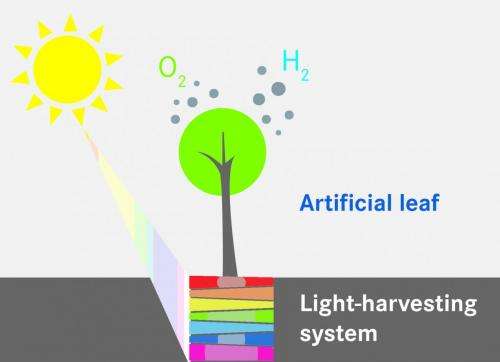The path to artificial photosynthesis

Scientists at the Helmholtz Center for Materials and Energy in collaboration with the School of Chemistry and ARC Centre of Excellence for Electromaterials Science at Monash University, Australia, have precisely characterized a manganese catalyst's electronic states. The catalyst is capable of converting light to chemical energy.
Through their work, Professor Emad Aziz, head of the HZB Institute "Methods for Material Development", Professor Leone Spiccia from Monash University and their teams have taken an important leap forward in understanding photosynthesis - the method green plants use to obtain energy - in artificial systems. Today findings of the team have been published in the journal ChemSUSChem and recently in the renowned Royal Society of Chemistry's Journal of Materials Chemistry A.
If sunlight could effortlessly be converted to chemical energy, our energy troubles would be a thing of the past. Green plants have evolved a special kind of mechanism to help them do just that: photosynthesis, the process by which plants take sunlight and, with its help, produce high-energy substances like sugar from water and carbon dioxide. But the molecules located in the so called "oxygen evolution centre" that facilitate this series of steps inside a plant cell are highly complex and sensitive. A current mission of scientists is simulating them in a laboratory setting and optimizing them for commercial energy production.
At his institute, Emad Aziz is doing research on artificial water splitting catalysts with the goal of getting them to perform at the level of the oxygen evolution center of photosynthesis. A while back, the scientists figured out what the chemical nature of these types of energy converters would need to be. Top candidates are manganese complexes embedded in a nafion matrix, a teflon-like polymer. Leone Spiccia´s lab developed and provided the samples. He says: "Under a bias, our manganese complexes produce nanoparticles of manganese oxides within nafion matrix. When exposed to light and biased simultaneously, these oxides promote water oxidation, a key and challenging reaction associated with the splitting water into oxygen and hydrogen. The hydrogen can be stored as an energy carrier."
"The next step was to figure out which of the potential manganese complexes in nafion yields the best manganese oxides," says the scientist in charge of the experiments, Munirah Khan of the Freie Universität Berlin, holder of a DAAD and HEC(Pakistan) scholarship. She studied the formation of manganese oxides and their catalytic effect using X-ray light at BESSY II, the HZB's synchrotron radiation source. In her doctorate research work, Khan used the RIXS method, which allowed her to select and further investigate the manganese species involved in catalytic processes with high precision.
Of the various manganese complexes, one in particular - designated Mn(III) by the scientists - turned out to be the one that most efficiently formed manganese oxides. "We are developing our methods to construct multi-dimension catalytic pathways for such novel materials in the energy and time scales. Our goal is to provide synthetic chemists with a full picture of the catalytic process under real test conditions in order to enhance their work on the function of these materials," says Emad Aziz, "and figure out if and under what conditions it might be used for technological application in converting light to chemical energy. If we succeed, it could mean we're well on our way towards a continuous, environmentally-friendly, and cost-effective storage form of solar energy."
More information:
DOI: 10.1002/cssc.201403219
DOI: 10.1039/c4ta04185b
Journal information: Journal of Materials Chemistry A
Provided by Helmholtz Association of German Research Centres





















